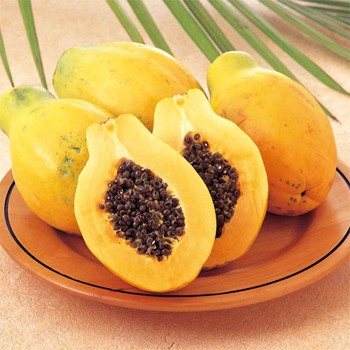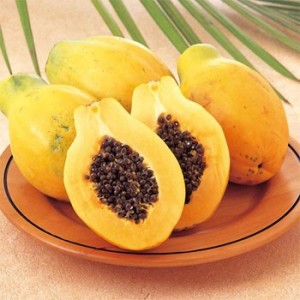
The pawpaw is one big, lush, and juicy fruit, with its hundreds of tiny black “squashy” seeds. This is one fruit you can enjoy regularly because it is in season virtually all year round. Besides its remarkable health benefits, it is one succulent fruit you can eat and prepare in a variety of ways. So, let’s learn more about the pawpaw, also called papaya.
A brief, juicy, history
The fruit commonly called pawpaw, or papaya, is scientifically known as Carica papaya. It belongs to the custard apple family, a large family of trees, shrubs and lianas that are widespread throughout the old and new tropics. This group includes other delights such as cherimoya, soursop, sweetsop and, of course, the custard apple which is the botanical family’s namesake.
The pawpaw is packed full of vitamins and minerals
The pawpaw fruit has a high nutritional value which surprisingly exceeds that of peaches, grapes, and apples in vitamins, minerals, amino acids and calories. In addition, it is an excellent source of folate, dietary fibre, and vitamin A, C and E. Rich in antioxidant nutrients, flavanoids and carotenes, pawpaw also contains iron, calcium, riboflavin, thiamine and niacine, howbeit in trace quantities.

Why the pawpaw is good for your body
1. Eating pawpaw after a meal makes for better digestion and prevents bloating.
2. Pawpaw has anti-inflammatory properties and can thus ease the severity of osteoarthritis and rheamatoid arthritis. Furthermore, it lowers inflammation in the body and relieves the pain and oedema induced by sport injuries.
3. Its high antioxidant content can prevent cholesterol oxidation and can be used as preventive treatment against strokes, diabetic heart disease, atherosclerosis, heart attacks and even cancer.
4. Generally, pawpaw strengthens the immune system and helps prevent colds and flu.
5. Furthermore, leaf and bark extracts can be used to handle toothaches, mouth gums and skin wounds that don’t heal quicky.

Serve up your pawpaws nicely
Eat raw. Enjoy your pawpaw fresh. Cut them in half and scoop out the seeds. Slice and serve.
Pawpaw juice and smoothies. Blend fresh pawpaw to create a delicious juice or smoothie.
Fresh papwpaw can also be used in making pawpaw milkshakes and ice-cream.
Bake some treats. substitute for banana in banana bread recipes for a great tasting bread. Use also in baking pawpaw muffins and pies.
Enjoy your pawpaw as a vegetable. Slice them up nicely; mix with other vegetables like cabbages, cauliflower, and lettuce for a delicious vegetable salad.
Mix up some cubed pawpaws with other fruits like watermelons, pineapples, bananas, tangerines, and apples for a tasty fruit salad.


